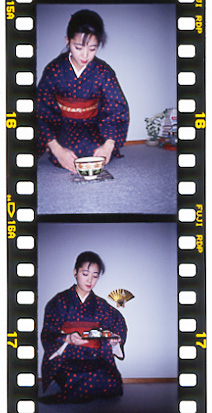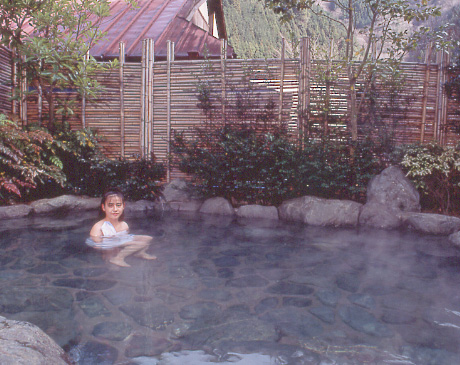|
A Place in the Japanese Soul
Moscow to Beijing via Mongolia The World's Gingseng Capitol Pacific Rim Delux Hotels Guide |
CONTACT US
|
ADVERTISING INFO
© 1996-2013 Asian Media Group Inc
No part of the contents of this site may be reproduced without prior written permission.
ESSENTIAL JAPAN
PAGE 3 OF 3

An attendant practices the tea ceremony in her free time. Attendants are required to master Japanese traditions. |
There are two large festivals each year in Sumatakyo. During the fall the village celebrates the Japanese Maple Festival. This festival shows kagura, a sacred Shinto music and dance. The stage for the kagura is adorned with green, red, purple and yellow origamis cut as lady decorations. The performers dance wearing traditional Shintoist costumes and masks inherited from village history. Being selected to perform in the maple festival is considered an "honorable thing" among villagers. After the kagura, the locals and tourists march around the village holding torches and looking at the spectacular fireworks.
The other important festival takes place during the summer, jazz fans from all over Japan make a tour from Tokyo to attend Sumatakyo's Jazz Festival. The fans perform and attend a variety of outdoor concerts until late in the night. The quiet summer nights of Sumatakyo are an open invitation for fun. After your first festival you will end up promising that it won't be your last.

The outdoor bath, built with stones, offers a memorable view of the mountains surrounding Sumatakyo. Many guests come to Suikoen for its outdoor bath. |
Tourism in Sumatakyo is a young industry established in the 1960s. Suikoen, its very first inn, was established in 1961 when the hot springs were discovered. At the time skeptical villagers considered it a big gamble, but as soon as the hot spring was discovered, inns began opening one after another. For a small village that could offer only hot springs and nature, it was a daring investment. Nor has the path to becoming a major tourist attraction been smooth.
[CONTINUED BELOW]
One of the saddest moments of its history is known as the Kin Kiro incident. In 1968 Kin Kiro, a Corean (Korean), occupied one of Sumatakyo's inns and held a family hostage for days. During this ordeal Kin Kiro summoned the media and revealed the many instances of discrimination he had suffered in Japanese society. Sumatakyo, once an unknown little village, was suddenly the center of national and international attention. The Kin Kiro incident sent a message to Japanese society, but there is still a long way to go in improving relations between Japanese and Coreans.
Although Japanese society has become immersed in its economic success and devotes its attention to the bright, colorful side of life, for local people the Kin Kiro incident is an unforgettable memory. In Sumatakyo I can still feel echoes of Japan's past, of the sadness that some have experienced in the long road to overcoming discrimination. The Kin Kiro incident depressed tourism in Sumatakyo for years. Only the passage of time reversed the fortunes of the tiny village.

The Bridge of Dreams crosses the emerald waters of Sumata River, within walking distance of Sumatakyo |
I had often felt the loneliness and confusion of my existence in the threateningly sophisticated life of Tokyo. I found a part of myself as "un-myself", disconnected from my origin. Tokyo life possibly makes us "Tokyonese", a people who searches for sophistication or success commensurate with economic progress while forgetting who we are. Japan is an Asian country but Tokyonese tend not to feel their Asian origin in their everyday lives; while having a strong identity as a Tokyonese, I found myself living lost in my life.
The vivid nature and kindness of Suikoen give us the energy to face the difficulties in our lives. Sumatakyo tells me that there are enough things to encourage me whatever difficulties I face in my life. After I moved to the United States, I realized the importance to my life of the existence of Sumatakyo. When I return to my Asian friends from difficulties in American society, I experience a feeling similar to visiting Sumatakyo. There, people are welcomed regardless of failure in their jobs, family matters or love affairs. Even now I visit Sumatakyo during holidays when I return to Japan. This is not just a tourist place -- Sumatakyo is jade that shines in my mind through the rough waves of everyday life. I wear it every day and try to remember my origin and identity.
|
"In 1968 Kin Kiro, a Corean (Korean), occupied one of Sumatakyo's inns and held a family hostage for days." |
